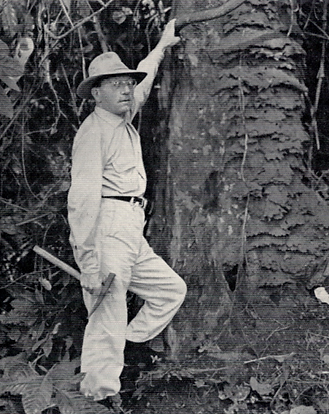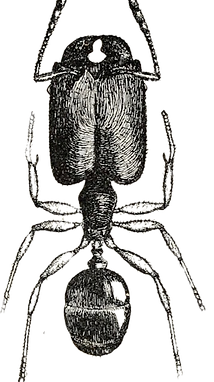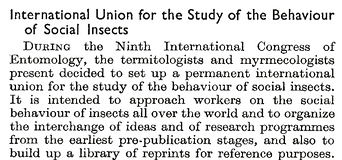
Our history
Founding the IUSSI
The IUSSI was born in Paris in 1952, the brainchild of the German ant biologist Karl Gösswald and the French termitologist Pierre Paul Grassé. At the previous year's International Congress of Entomology, Gosswald and Grassé had agreed that there was a clear need for a dedicated society focused on the social insects, and announced the inception of the IUSSI in Nature in 1951.
The society's journal Insectes Sociaux was launched in 1954. The inaugural issue included diverse contributions, including how honeybees manage the winter, the phylogeny of ants, aggression by workers, and a study by E. O. Wilson on larval competition.


Termitologist Pierre Paul Grassé (1885-1985). Image: Dictionnaire Amoureux des Fourmis.

1953, the second year of the IUSSI
"Riche en conséquences philosophiques et pratiques, apparaît l'étude des insectes sociaux. Elle comble les voeux du chercheur amoureux de l'étrange et de l'inattendu, mais aussi et surtout de celui qui essaie de découvrir l'essence des réalités biologiques les plus complexes, fleurs ultimes de l'arbre de vie."

"The study of social insects is rich in philosophical and practical consequences. It fulfils the needs of the scientist who loves the strange and the unexpected, but also and especially of those who seek to discover the essence of the most complex biological realities, the ultimate flowers of the tree of life."
Pierre Paul Grassé, at the opening of the IUSSI Congress in Wurzburg, 1955

International Congresses
To date, there have been 19 international congresses, which now occur every four years. The 20th will be held in Freiburg in 2026. Alongside the international congresses, the different regional sections hold regional and national conferences and symposia.
So far, the IUSSI's international congresses have been held in Europe, North America, South America, Asia, and Australia.

Ant biologist Karl Gösswald (1907-1996), one of the two founders of the IUSSI.
Image: Zobodat.
1st
Paris, 1952
6th
Bern, 1969
11th
Bangalore, 1990
16th
Copenhagen,
2010
2nd
Wurzburg, 1955
7th
London, 1973
12th
Paris, 1994
17th
Cairns, 2014
3rd
Paris, 1957
4th
Pavia, 1961
8th
Wageningen,
1977
9th
Boulder, 1982
13th
Adelaide, 1998
14th
Sapporo, 2002
18th
Guaruja, 2018
19th
San Diego,
2022
5th
Toulouse, 1965
10th
Munich, 1986
15th
Washington DC, 2006
A Cephalotes ant worker from South America, famous for flat heads that function as doors to the nest. (Image: Wheeler, 1910)

A recent analysis of the IUSSI's history by Buttstedt and coauthors (2024) highlights historic imbalances in representation between different geographical regions, and calls for 'greater inclusivity in the academic community'. To read the paper in Insectes Sociaux, see here. We are working to improve equality, diversity, and inclusion. To donate or fundraise for the Congress Travel Fund, see here.

Improving global inclusion
Contributions to IUSSI conferences, from Buttstedt et al. 2024. Reproduced under CC BY 4.0.

Attendees of the first IUSSI meeting, in Paris, 1952. Image: Dictionnaire Amoureux des Fourmis

The Japanese Section in 1954, at the 2nd Annual Meeting, Tokyo
Further reading
-
A history of the early days of the IUSSI was published by Dr Christopher Starr in 2003, in Genes, Behaviors, and Evolution of Social Insects (eds. Kikuchi, Azuma, & Higashi), and is available online.
-
A detailed resource containing materials from many of the IUSSI's international congresses is maintained by Professor Alain Lenoir at Dictionnaire Amoureux des Fourmis
The 1951 announcement in Nature of the founding of the IUSSI
